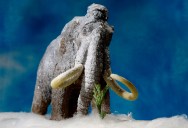Scientists Said They Could Revive A Woolly Mammoth By 2027. That Timeline May Be A Lot Sooner Than Expected.

Scientists said a while ago that they would be able to fully resurrect the woolly mammoth from extinction by 2027.
Now that we’re three short years away from that self-imposed deadline, the scientists involved say they’re pretty close to the finish line.
De-extinction company Colossal Biosciences are using the edited genes of an Asian elephant, and have now been able to propagate those cells indefinitely in a lab.
Asian elephant DNA is a 99.6% match to the DNA of the woolly mammoth, so the team believes they can tune the animal to closely resemble the ancient species in this manner.
To achieve this, they’re using the first-ever induced pluripotent stem cell (iPSC).

And iPSC is a single cell source that offers access to every other type of cell in a body; this would potentially allow the creation of sperm and egg cells, as well.
Eriona Hysolli, head of biological sciences at Colossal, recently made a statement about their research.
“Elephants are a very special species, and we have only just begun to scratch the surface of their fundamental biology.”
The firm, based in Dallas, has been given hundreds of millions of dollars in funding and has the stated goal of not only bringing the mammoth back from extinction, but of reintroducing it into its original ecosystem.
The mammoths original populated parts of the arctic. These new beings will be “functional mammoths,” and not a direct genetic match to the species that went extinct.

The would still be able to strengthen local plant life with their migration patterns and dietary habits, however.
George Church, Colossal co-founder and Harvard geneticist, issued a statement about why he thinks their work is so important.
“Elephants might get the ‘hardest to reprogram’ prize, but learning how to do it anyway will help many other studies, especially on endangered species. This milestone gives us insights into developmental biology and the balance between senescence and cancer.”
Since the team can now mature the elephant’s iPSC cells in the lab, they should be able to use them to grow an edited cell all the way through the 22-month gestation period.
Whether or not those babies will grow into healthy adults is really anyone’s guess at this point.
There are many who have ethical reservations about this project – the age-old question of whether or not you should do something just because you can.
Ecologist and conservation biologist Douglas McCauley says we have no business introducing what is essentially a new species into the Arctic ecosystem.

After all, even if it looks like a woolly mammoth, it’s not, so we have no idea how it will behave once let loose in the wild.
Not to mention the ethics of spending millions of dollars to bring back an extinct species – millions of dollars that could possibly be better spent helping the species still alive (or the planet) stay alive instead.
I’m sure these are just a couple of the arguments against this sort of research, but honestly, it’s probably a waste of breath.
Colossal has made its choice, and believes that their work will produce something very special in the end.
If you thought that was interesting, you might like to read a story that reveals Earth’s priciest precious metal isn’t gold or platinum and costs over $10,000 an ounce!

Sign up to get our BEST stories of the week straight to your inbox.




